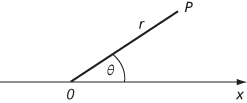polar coordinates

The polar coordinates of P
Suppose that Cartesian coordinates are taken with the same origin and the same unit of length, with positive x-axis along the directed line Ox. Then the Cartesian coordinates (x,y) of a point P can be found from (r,θ), by x = rcosθ, y = rsinθ. Conversely, the polar coordinates can be found from the Cartesian coordinates by  , and θ is such that
, and θ is such that

(Note that θ = tan−1(y/x) but this is not, of itself, sufficient to uniquely determine θ.) In certain circumstances, authors may allow r to be negative, in which case the polar coordinates (r,θ) give the same point as (–r,θ + π).
In mechanics, it is useful, when a point P has polar coordinates (r,θ), to define unit vectors er and eθ by

where i and j are unit vectors in the directions of the positive x- and y-axes. Then er is a unit vector along OP in the direction of increasing r, and eθ is a unit vector perpendicular to this in the direction of increasing θ. These vectors satisfy er∙eθ =0 and er×eθ =k, where k = i×j. See radial and transverse components.
- education theory
- efficiency
- efficiency
- effort
- Efron dice
- Egyptian fraction
- eigenbasis
- eigenfunction
- eigenspace
- eigenvalue
- Einstein, Albert
- Einstein's notation
- Eisenstein's criterion
- elastic
- elastic collision
- elasticity
- elastic potential energy
- elastic string
- electric field
- electromagnetic potentials
- electromagnetic wave
- element
- elementary column operation
- elementary function
- elementary matrix